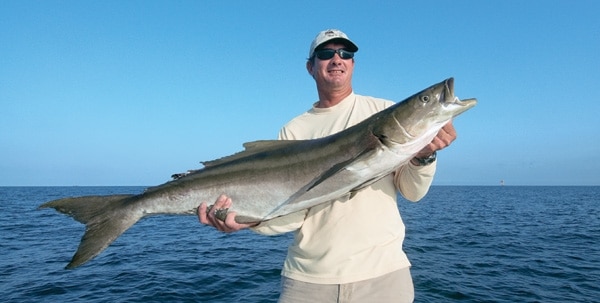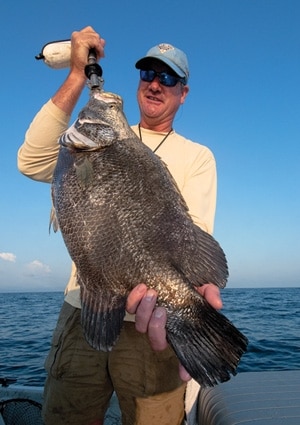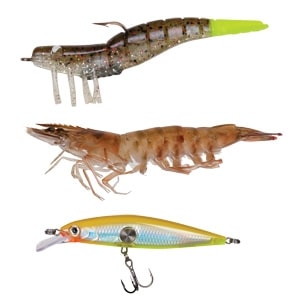
I didn’t test very well in grade school, maybe because my mind tended to wander. When my teacher mentioned that fiery Louisiana politician nicknamed Kingfish, all I could think about was my dad’s fish-scarred 25-foot Mako, half-spooled Penn Senators and bucket full of beat-up Russelures. Back then that was all we needed for a fishing fix off the Louisiana coast. And while that old-school stuff still works just fine, I never imagined the kind of tackle testing we’d be doing in the same waters some 30 years later.
**Tackle Test
**Considering we fish in an age in which we understand unpalatable fishing acronyms and terminology such as quotas, closures and reduced limits, it’s refreshing to go back to some angling roots. With the sheer number of prolific nearshore game fish such as king mackerel, tripletail, cobia and mahimahi, Louisiana just makes perfect fishing sense.
Captains Guy Stansel and Bobby Stansel of Hackberry Rod & Gun couldn’t agree more – they aren’t thinking about school or tests anyway. Not even work. Those commitments are all done for now. It’s their day off from positioning clients a cast away from hard-charging redfish and trophy seatrout. While that’s good stuff, they are just fine with a change-of-species pace. Even though those inshore species are all about topwater explosions and powerful runs, they can’t make drag washers as hot as Tabasco and light-action rods beg for mercy like their offshore counterparts. “You know, we get some awesome calm weather down here in late summer and early fall,” says Bobby. “We typically have five or six days of light north winds following weak late-summer and early fall fronts.” Fishing has been great following the hurricanes of the last several years, and while fishermen do enjoy the bloom these storms provide, the fact remains Saturdays can become a bit crowded. “A string of good-weather days provides us wide-open, uncluttered open-water space for fishing the nearshore Gulf waters,” explains Bobby. “Abundant shrimp boats, buoys, reefs and rigs offer tremendous opportunities to have some light-tackle fun with some bigger-than-normal species for our trout gear. King mackerel, cobia, tripletail and mahimahi make their way close to shore, and we engage all of them on the same tackle and lures we throw at trout and reds – and we catch them too!”
**Into the Sea
**Glassy seas meet us as we exit the estuary, enter the Gulf and veer southeast. As we run toward our destination, the only waves we can see are from the supply and crew boats lazily making their way to the oil and gas rigs on the horizon. Even though we planned over morning coffee to set a course toward the first set of rigs, our zeal to wet some line magnetically pulls us in the direction of the buoy chain. “Let’s fish for a tripletail,” Guy says as he steers his boat hard over. About that same time, we watch the sea slowly turn from a sandy green to a deep, dark, clear green just a quarter of a mile outside the pass.
In late summer and fall, a pattern emerges: Warm ocean eddies ebb and flood their way north, meeting up with estuary outflows from the first of weak cool fronts. Mullet and pogy begin to stack up along current breaks and sargassum weed lines. As these vast schools filter out to sea, offshore species are eager to meet them.
As we arrive at the buoy, Guy readies his trolling motor and Bobby Carolina-rigs a live shrimp on a Kahle hook. Just up-current from the buoy in about 30 feet of water, Capt. Stansel wastes little time hooking up with a tripletail of at least 15 pounds. He says the tripletail fishing here is excellent: “We have a good run of them in June and again in late summer.” We motor to several more buoys, sight-casting to tripletail as we make our way southwest. At each buoy, we entice several more “three-tails” utilizing a Berkley Gulp! Shrimp in New Penny color. Stansel continues: “By late summer, you can just about set your watch to it; rips form anywhere from seven to 10 miles off the pass and are loaded with tripletail, dolphin and cobia. On guided trips with our customers, we usually start by fishing the beaches for seatrout, then move offshore to look for these species. We use our trolling motors and quietly troll along, sight-casting alongside sargassum rips.”

We continue fishing what seems an endless supply of buoys, slowly moving farther into deeper water. In the distance, several shrimp boats appear to be tied together and at anchor. As we get close, we see the water behind them churning as jack crevalle, bonito and sharks feast under the trawls. Bobby fights several large sharks and bonito on his “shrimp-boat special,” a large MirrOlure She Dog sans hooks. “Makes for a quick release,” he quips. We each take turns landing jacks, sharks and bonito while our trout and redfish tackle perform admirably. It is time to move on.
Our third structure is an old oil platform turned artificial reef. We switch our bait to live mullet and chum with our remaining live shrimp. We Carolina-rig our mullet on fluorocarbon leaders double-Uni-knotted to 30-pound PowerPro. Each and every drop, we watch beautiful 4-pound seatrout come up in the emerald water. Just as we begin to ice a few for dinner, a cobia appears alongside. Guy quickly tosses a 4-inch MirrOlure MirrOdine in front of the fish – a solid 40-pounder – and settles in for the fight, while Bobby is in the middle of his own tug of war with a bull red of some 20 pounds. As if the melee weren’t enough, a king mackerel grabs my seatrout lunch and peels off 60 feet of line. Chaos. The good kind. After a few high-fives and laughs, we head in for lunch.
As we begin our short run to the pass, I recount the day’s light-tackle adventure. Looking back, it was like a nearshore smorgasbord – a big fish buffet of different species. Lunch. Buffet. Smorgasbord. It doesn’t take long for my mind to wander again.
Louisiana Nearshore
_

Rods:_ 7-foot conventional rods, medium-heavy with light tips.
Reels: Conventional bait-casting reels.
Lines: 30-pound braid.
Leader: 9 feet of 20- to 25-pound-test fluorocarbon joined to main line with a double Uni-knot.
Lures/Terminal Gear: Suspending or slow-sinking plugs such as MirrOlure She Dogs and Rapala Clackin’ Minnows, as well as shrimp imitations such as Berkley Gulp! Shrimp and D.O.A. Shrimp.
Baits: Live finger mullet and live shrimp.
What: Cobia, king mackerel, bonito, seatrout, red drum, shark, jack crevalle and mahimahi.
When: Late summer through fall.
Where: Texas and Louisiana Gulf Coast.
Who: Capt. Guy Stansel and Capt. Bobby Stansel
Hackberry Rod & Gun
337-762-3391
www.hackberryrodandgun.com









